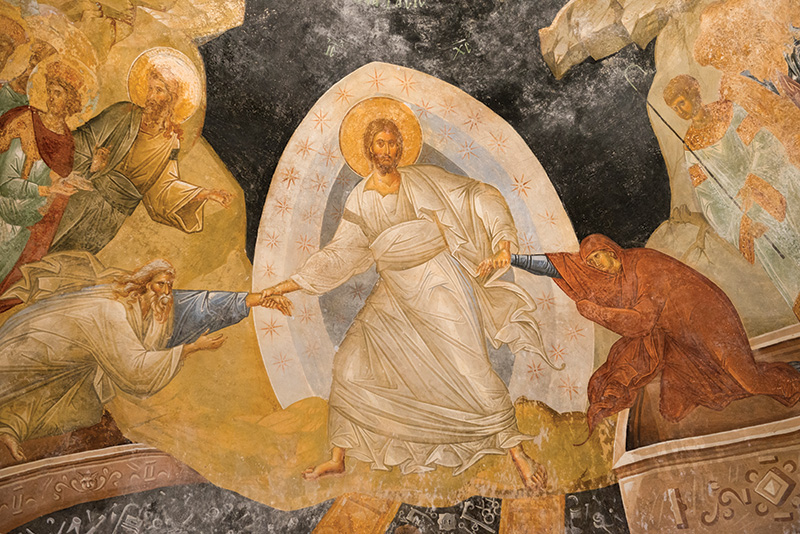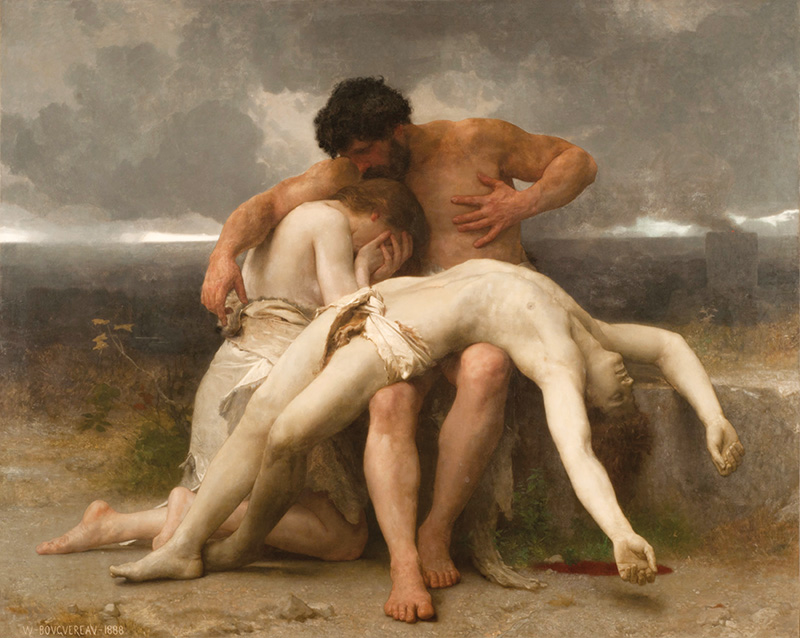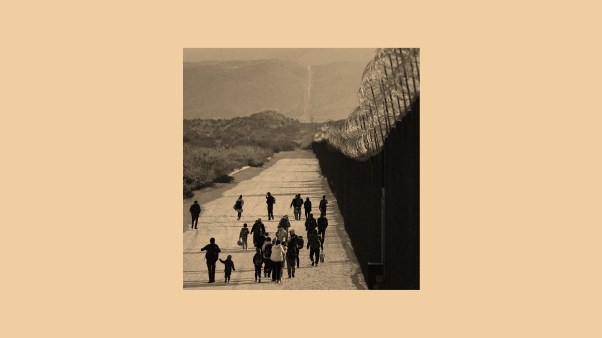If we’re lucky enough to grow up with a mom, we learn a lot from her. For good or for ill, we watch the way she manages life and we often follow suit, even without meaning to. So, what can we learn from the Bible’s first mom, Eve, named in Scripture as “the mother of all the living” (Gen. 3:20)? Though our trust in Eve’s guidance is significantly diminished by her decision to disobey God, what can she still teach us about how to live well in God’s world?
Eve appears in four scenes in Genesis: her creation, her sin, her giving birth to and naming Cain and his brother Abel, and her giving birth to and naming Seth. Further in the Bible, she’s described as having been deceived (1 Tim. 2:14), and in John’s vision, a woman much like Eve or Mary gives birth while a dragon waits to devour her baby boy (Rev. 12).
Eve’s story has grown over time so that our wary assessment of her is often based more on tradition than on the Scriptures themselves. Amanda W. Benckhuysen notes in The Gospel According to Eve that “the majority of early interpreters concluded that Eve was an inferior and secondary creation who bore primary responsibility for plunging the world into sin and strife.” For example, Aquinas presented Eve as the greater sinner, who as a woman was “defective and misbegotten.” However, the Bible does not present her as a seductress, a bimbo, or someone who is tragically lost—nor does it portray her as a mother we should disown.
Eve’s life begins with a celebration, her arrival heralded by the Bible’s first man. He is not responsible for making her, but he receives her as himself, proclaiming “bone of my bone and flesh of my flesh,” recognizing they belong together (Gen. 2:23).
In Genesis 2’s slower, narrative account of human origins, God performs a surgical procedure while the man is asleep, removing not just Adam’s rib, but—in a more accurate translation—his very “side.” As the narrator tells it, God splits the human down the middle, providing the material needed to result in a male and a female.
Also, the English word helper does not do justice to how the Hebrew word ezer describes Eve’s role (v. 18). Rather than a servant, God produces an ally corresponding to the man, who can share his tasks of cultivation and care of the garden.
I imagine Adam and Eve’s early days were spent in delightful discovery of God’s generous garden. They picked and ate fruit, cut back trailing vines, pulled weeds, cared for animals, and learned to work the soil. Part of their job description in Genesis 2:15 was to “keep” or “guard” the garden. Their role was active, not passive. Together they shouldered the responsibility, which must have involved problem solving and collaboration.
Together they could enjoy God’s provision and avoid what was off-limits. Except they didn’t. Eve became a tragic figure in short order. We don’t know how much time elapsed between her creation and the humans’ rebellion, but in narrative time, it’s merely a blink.
The story of Eve’s disobedience in Genesis 3 is tantalizing, leaving open many possibilities. Her version of God’s command is more stringent than the original, including a warning to not even touch the tree. First Timothy 2:14 is often taken as an indictment of Eve for her gullibility, but Paul could have intended it the other way around: Eve’s case may show that women ought to be taught carefully, rather than pushed away from gaining knowledge. Had Adam exaggerated when telling her about the command? Or was Eve trying to play it safe by adding restrictions?
The serpent convinced Eve that God’s command could not be trusted—that God was holding out on her by preventing access to what would benefit her, and that deification rather than death would result.
Here’s the problem: The Tree of the Knowledge of Good and Evil represented the pursuit of that knowledge apart from God. Adam and Eve already had access to the one who would teach them good from evil as they walked with him in the garden. Eating from the forbidden tree was an attempt to gain knowledge outside of that relationship—to become their own arbiters of truth.
After the fateful disobedience to his command, God seeks out the humans. He addresses Adam first, likely because Adam is the one to whom he gave the command.
Next, God addresses Eve directly. It’s worth noting that God does not hold Adam accountable for Eve’s sin; she possesses her own dignity as a moral agent. God’s question gives her an opportunity to confess: “The serpent deceived me, and I ate” (Gen. 3:13).
Katharine Bushnell, a medical doctor and Bible scholar who died in 1946, reframes this scene for us. In God’s Word to Women, Bushnell suggests that Eve’s answer to God was better than Adam’s. Adam casts aspersions on God for giving him Eve, referring to her as “the woman you put here with me” (v. 12). It’s easy for us also to point the finger at Eve, blaming her for the human predicament, the path of sin we all have chosen. Eve instead correctly identifies the serpent as the tempter and herself as the one who made the choice.
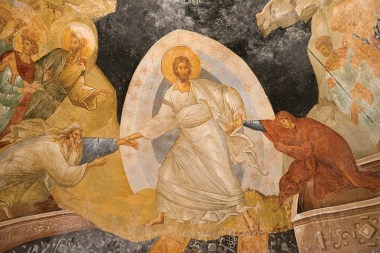 Getty / Joel Carillet
Getty / Joel CarilletIn response, God curses the serpent, relegating him to the lowliest position. He tells the people, too, that hardships will come of their sin.
Then, we hear a clear note of hope: God promises that the woman will bear a child who will bruise the serpent’s head, even while the serpent strikes the heel of the deliverer (v. 15). Ultimately, the creature through whom evil gained a foothold will be trapped by the underside of a human foot and destroyed.
The enmity that arises between Eve and the serpent is a good sign. With eyes wide open, Eve and her seed are determined to bring creation into submission to the command of God.
Eve clearly and unequivocally made the wrong choice in the garden, with her husband’s full knowledge and participation. She meant to disobey. She thought she had found a more reliable source of wisdom. Though they don’t experience physical death right away, Adam and Eve’s relationships are fractured at every level. They hide from God, blame each other, and lose access to God’s garden of abundance. Eve knew she had been deceived.
For these reasons, Eve is not exactly hailed as a Bible hero. Her reputation as rebellious is well-earned. We’ve been living with the consequences of her transgression ever since Eden. Might we even resent her?
Yet, as with any Bible character, Eve’s moment of failure does not fully define her. Instead, we can find tremendous encouragement in her story. God’s response to her sinful decision opens the pathway for us to enter the kingdom of God. He could have scrapped creation in order to start over. But that’s not what God did.
Instead, God announced a solution to the unraveling of his plans for creation through Eve’s offspring. By the end of the story, rather than the source of evil, God presents Eve as the source of redemption. Her childbearing, fraught as it was, would result in the restoration of all that went wrong in the garden. In this sense, she would be the vehicle of salvation.
All humans—male and female—were made as God’s image and appointed to rule creation on God’s behalf (Gen. 1:26–28). Together we were tasked to “fill the earth and subdue it.” Eve’s failure to subdue the serpent, and Adam’s failure to support her in this essential task, led to their undoing. Realigning herself with God’s purposes puts Eve at odds with God’s enemies. That’s exactly where she should be.
Perhaps God’s declaration of enmity between Eve and the serpent is what inspires Adam to name her Eve (Hebrew Hava), which sounds similar to the word for life. Adam admires her because she will become “the mother of all the living” (3:20), giving life to the generations that follow. She and Adam were also the first of us—our mother and father—in repudiating our tempter and our sin and trusting God’s promise.
God mercifully clothes the humans and sends them away from the garden, preventing access to the Tree of Life. Unending life will come eventually, but first the snake needs to be crushed.
Outside Eden, in Genesis 4:1, we witness Eve’s joy at the birth of her first son. She knows that this birth is the path of fulfillment to God’s announcement in the garden. The New English Translation renders her exclamation as “I have created a man just as the Lord did!”
The Hebrew word for created sounds like Cain—an appropriate wordplay for the first birth in the Bible. It’s a significant moment in the narrative, given God’s declaration that Eve’s offspring would crush the head of the serpent. She rightly recognized that the miracle of childbirth is a miracle of creation. Will this be the son?
He is not. Nor is her second son. Rather than crush temptation, depicted in 4:7 as an animal crouching at Cain’s door, ready to pounce, Cain cooperates with sin by murdering his own brother.
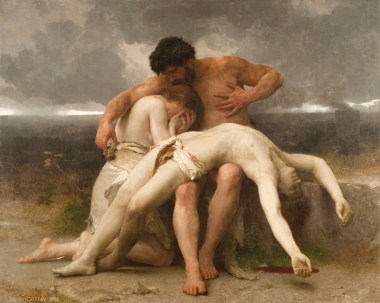 Wikimedia
WikimediaThe text doesn’t tell us how Eve reacted, or whether she held on to hope in God’s promise in spite of the loss of both of her sons to death and exile. I imagine Eve carried that burden of maternal loss and dashed hopes to her death. Eve bears another son in 4:25, saying that he would replace Abel. Though we don’t hear of any tussle between Seth and the serpent, Seth is listed as Jesus’ direct ancestor in Luke 3:38.
For the rest of the First Testament, we await the descendent of Eve who will crush the serpent. The echoes of God’s promise in the garden reverberate.
For example, we witness this centrality of God’s promise to Eve in the imprecatory psalms. In Cursing with God: The Imprecatory Psalms and the Ethics of Christian Prayer, Trevor Laurence explores how these psalms participate in the wider biblical story by calling upon God to bring an end to wickedness and establish his kingdom.
The disordered world that resulted from Eve and Adam’s joint rebellion could only be restored through the partnership of their offspring with God in subduing those who oppose God’s rule.
Laurence notes that the imprecatory psalms evoke the Eden narrative repeatedly. They often speak of enemies as “snakes” or deceivers whose “heads” need to be crushed and refer to the “seed” of the righteous whose “heels” are being watched by their enemies (Ps. 58:4–6; 56:6). The cumulative effect is a sense that God’s purposes expressed in the Garden of Eden story are still being worked out as God’s people pray for the defeat of those who oppose God’s rule.
It’s worth noting that we’re not just talking about literal snakes here. Only those humans who align themselves with God’s commands are considered to be the “seed of the woman,” while people opposed to his rule are the “seed of the serpent.”
Gospel proclamation, then, issues an invitation to recognize the lordship of Jesus Christ. He is the seed of the woman. He has defeated Satan once and for all and is the seed of Abraham who receives the covenant promises. All those who follow Christ are reckoned as children of God and the seed of Abraham regardless of ethnicity, gender, or social status (Gal. 3:26–29).
John’s apocalyptic vision in Revelation includes a scene in which a pregnant woman travails in labor while a dragon waits to consume her offspring (12:1–17). While the vision includes a pastiche of symbolic imagery that appears in a number of apocalyptic texts, at the root of all of them is God’s announcement to Eve that her seed would crush the serpent’s head. Where else would John have turned to understand this striking scene?
By the time of John’s vision, the woman represents corporate Israel, which brings forth the Messiah under the pain of foreign domination. And the snake has morphed, becoming a seven-headed dragon, a composite of evil empires that oppose God’s rule and God’s people.
John makes sure we do not miss the thematic connection by interpreting the dragon for us as “that ancient serpent called the devil, or Satan, who leads the whole world astray” (v. 9). Though Genesis does not reveal the identity of the serpent, John’s vision interprets the primordial scene in retrospect.
The antagonism between the faithful people of God, awaiting the Messiah’s rule, and the dragon has reached a fever pitch. But Satan does not get the final word. The child is “snatched up to God and to his throne,” where he takes his place as ruler of the nations (v. 5). Satan is bound for a thousand years (20:2–3) and meets his ultimate end in the lake of fire (v. 10).
John’s vision in Revelation reaches its climax with a vivid scene of a restored garden in the New Jerusalem, where humans may again live in the presence of God (22:1–2). God’s intentions for creation are finally and fully realized in John’s glorious vision.
When we return to the beginning, it’s striking that God announces the promise of redemption to Eve, not Adam. The “mother of all the living” is the one through whom the promised seed will come. As Bushnell writes, “The Bible, from its opening chapters, pictures woman as allied with God in the eventual salvation of the world.”
Although Eve was partly responsible for the human rebellion in the garden, her failure alongside her husband was not the final word. Eve is neither a paragon of innocence or a paramour bent on seduction.
Rather, the Bible presents her as both paradigm for the essential participation of women in God’s work of redemption and as a complex person with a tragic story. And she is family—our mother in hope as well as in ancestry. As flawed and human as Eve was, in Bushnell’s words, “God has elevated her to the honorable position of an enemy of Satan and progenitor of the coming Messiah.”
Where does that leave us as Eve’s descendents? How does the command to “Honor your father and mother” (Ex. 20:12) apply to the “mother of all the living” whose choice led to a world of hurt?
Our duty here is not to try to erase the sin she confessed to God. Nor is it necessarily to honor Eve with imitation, although cultivation and motherhood are generally good and many of us are called to one or the other. The best way for all of us, male or female, to honor Eve is to maintain hostility toward anything that sets itself up in opposition to God’s kingdom. We learn from Eve to cultivate a wisdom grounded in what God says is good in his Word. And we celebrate the seed of Eve, our Messiah, Jesus, who crushed the Serpent and who invites us to announce the redemption available to all.
God first presents Eve to Adam as a companion in the task of caring for creation and heeding God’s command. When they leave the garden, she is Adam’s last hope for reversing the curse on creation. The sin of the “mother of all the living” did not erase the possibility of future women’s participation in redemption. Generations later, Mary’s willing submission to God’s invitation to bear the Messiah reverses the effects of Eve’s grave mistake. The one who was bruised for our sake bound Satan and will crush him once and for all.
Carmen Joy Imes is associate professor of Old Testament at Biola University and the author, most recently, of Being God’s Image: Why Creation Still Matters (June 2023).





